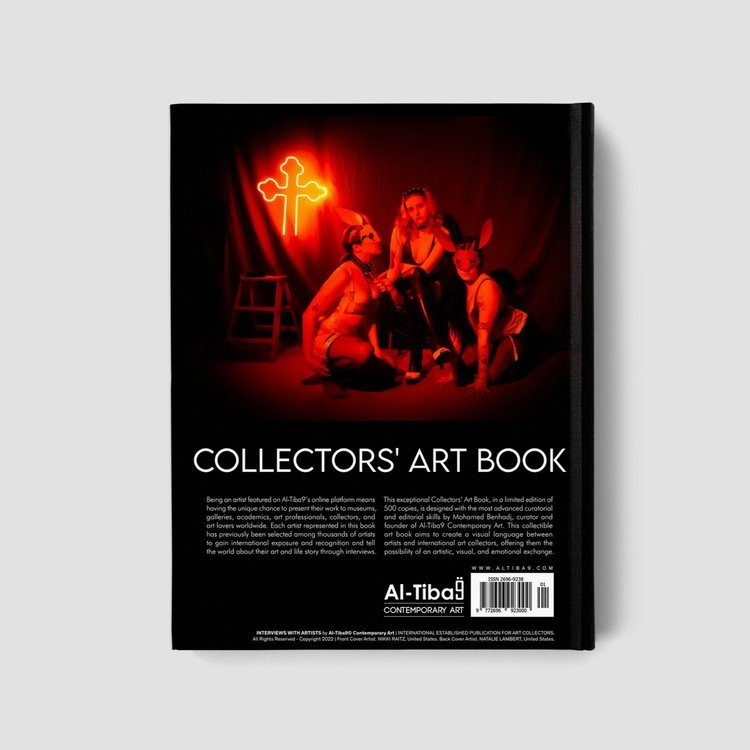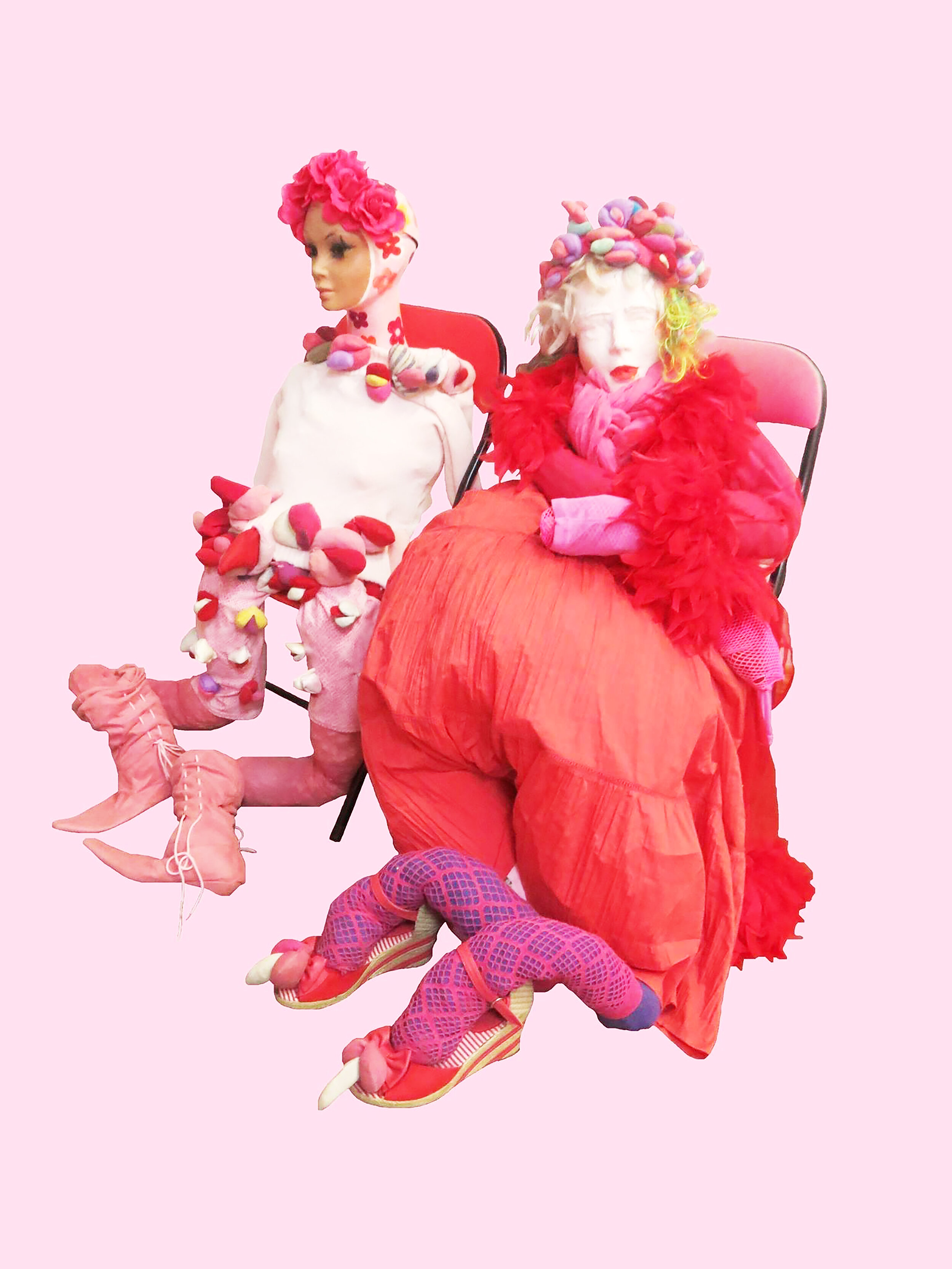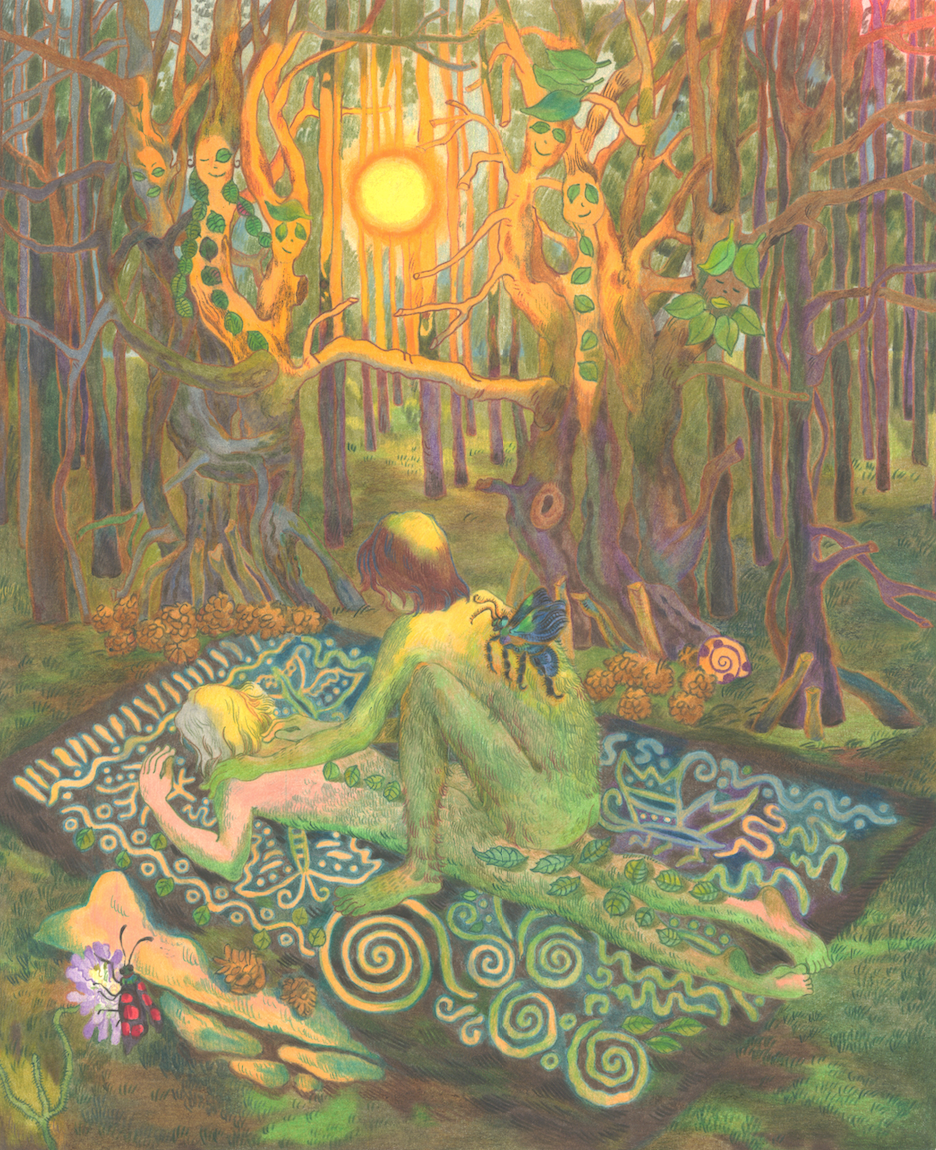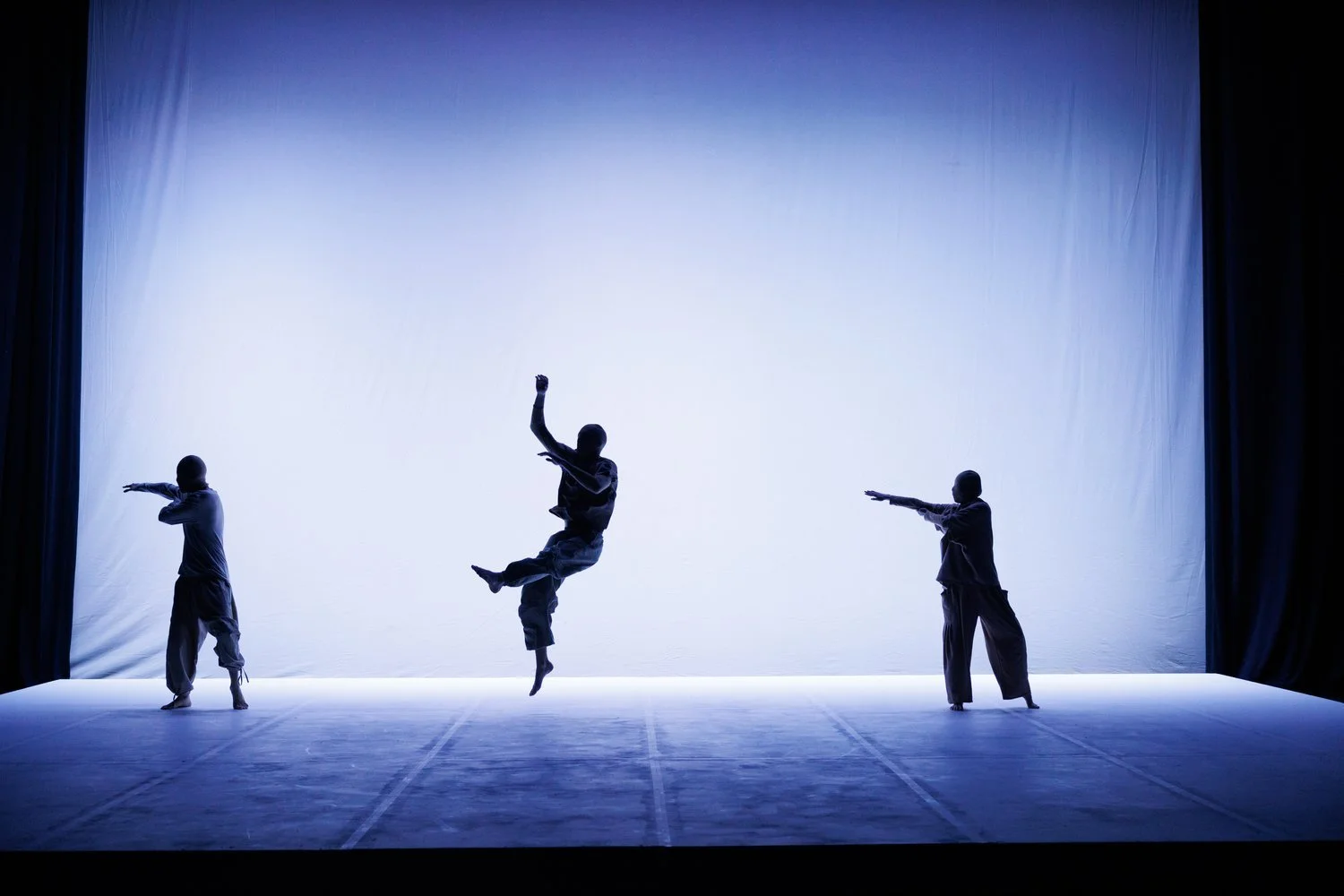10 Questions with Alexandra Holownia
Alexandra Holownia was born in Wrzesnia (Poland) in 1964, but she is currently based in Berlin. She first graduated at the Fine Art Academy of Warsaw, Poland, and later at the Art University of Berlin, Germany. She works as a performance artist, staging actions in public spaces. At the same time she is also an interdisciplinary conceptual artist, and works with costumes, sculptures, drawings, video, and creative writing.
Her feminist works call for socio-political tolerance, acceptance of human rights and freedom in sexual self-determination. Thematically, her works are concerned with gender and sexuality.
She deals with the issue of determination for women seeking release from traditional sexual roles and existing ideas of beauty, questioning the discrimination based on sex and imposed by the state. With the help of her art, she fights for a world free from patriarchy, in which all girls and women are liberated. Her work focuses on elements symbolizing both female and male genitalia, studying social problems related to genital taboos.
Alexandra Holownia aka Alexandra Fly© Frieze Art Fair London
ARTIST STATEMENT
Thematically, my works are concerned with gender and sexuality. I favor freedom, tolerance, and breaking the taboo of the vagina, but above all, the rights of women and the right to sexual self-determination and transgender. The more often we raise topics related to sexuality, the greater the chance for social acceptance, and patriarchy's overthrow.
Alexandra Holownia, Photo credit EJCziesla©
Why are you an artist, and when did you first become one?
The answer to this question goes back to childhood. I think that introducing children to art at an early age shapes sensitivity and instills the element of infantilism throughout their lives. As a 4-year-old girl, I lived with my parents in Warsaw, Poland, where my mother always took me to a children's theater. I really liked watching fairytales cartoons. After the performance was over, I didn't want to leave the theater. I kept asking what would happen next. I loved funfairs with houses of dreads or crooked mirrors. From an early age, I was fascinated by magical artificial landscapes. I still love a scary dark ride attraction, Phantom Manor or a Fantasy land area It's A small World in Disneyland Paris. At the age of 4, I was learning piano, rhythmics, and ballet. I also attended an art group in Warsaw; we lived in the Ochota district, where under the guidance of teachers, I started drawing. It was then that my passion for drawing, painting, and molding was born. The teacher who was leading the group and my parents liked my pictures very much, I was told that I draw nicely and I should develop my talent in this direction. I believed it. And my childhood experiences helped me later. As an older person, I knew that drawing is one thing I really can do. In high school, I had the highest grade only in art and sports. Besides, I liked visual artists in my youth. I was fascinated by their way of dressing, creating themselves, and the freedom they had in them. When I was 16, during my holidays in Swinoujscie, where the FAMA Art Festival for Academic art youth was taking place, I saw a Krakow painter Jan Sawka with friends painting on the beach. They looked cool, and Sawka drew something on canvas. Then I thought, oh he draws, I can do it too. Then it was decided that I would be an artist. I got into art studies at the Academy of Fine Arts in Poznań at the design department. Of course, during my studies in Poznań, I wanted to be the best, and unfortunately, I was the worst, which motivated me to test myself at another art university. I decided to continue my studies in costume and stage design at the Academy of Fine Arts in Warsaw. It was an elite postgraduate study. After their completion, many Warsaw galleries were open to me. I started to make exhibitions, doing performances, theater sets, and that's how I became an artist.
Could you tell us a little more about your background and how did you begin making art?
I was born in Western Poland in the small town of Wrzesnia. My father was an officer in the Polish Army, and his unit was just stationed in this city. Later we moved to Warsaw and years later to Poznań. We never had a permanent family home. I was used to moving and traveling since I was a child, which is also reflected in my work. Because of the performative artistic figure of Alexander Fly for 13 years I have been travel around Europe, the USA, presenting my walking performance every year in the context of mega exhibitions and international art fairs in London, Paris, Basel, Brussels, Miami, New York, Venice. Since 2016, I have personally participated in art performance festivals in Belgium, China, Cyprus, Czech Republic, Germany, Ghana, India, Italy, Ireland. Niederlande, Norway, Poland, Serbia, Spain, Switzerland, UK, USA. So I am always on the road, and it has become part of my art to travel and relocate.
I think that I started creating art while studying stage design in Warsaw. It was a very fascinating and fruitful time for me. The Stage Design Studies were based at the Studio Theater in Warsaw. The director was the famous director and visual artist Józef Szajna, a visual art theater pioneer. In addition to classes at the theater and at the Academy of Fine Arts, lectures were held at the State Theater School with great polish actors such as Wojciech Pszoniak and Zbigniew Zapasiewicz. My thesis was about the staging of James Joyce's Night City of 16 chapters of Ulysses.
This topic was suggested to me at the time by the director and visual artist Jerzy Grzegorzewski, who was my promoter. He was a Joysologist, and he directed Ulysses himself. Jerzy Grzegorzewski lit me up to see James Joyce. While working on Ulysses, I came up with a costume sculpture adopted by the actors in the performance and which could also serve as an independent sculpture. Did I realize this idea a few years later in my performance by Alexandra Fly Dance and my last show, How a wonderful World? Ulysses sculpture's first costume has also been presented several times in Galleries in Warsaw, Poznan, Kassel, and Berlin.
What aspect of your work do you pay particular attention to?
In 2020, I started to implement the slogan of Fluxus life is art, and art is life. Therefore, my last three performances from 2020 are based on my life experiences.
In the Domestic Patriarchy performance, which was shown for the first time at the KIPAF performance festival in Kolkata in January 2020, I presented the dialogue between my partner and me. I wanted to emphasize the patriarchal attitude towards women rooted in men.
In contrast, in the performance of Alexander Fly Dance Pandemic Home Performance played in May 2020 by Zoom for Hexxyduxxybox in New Delhi, I uttered sentences referring to being sent back by the false promises. I was waiting for a call from a close friend who said he would call me the next day and he never called me again. The dance used in this performance was influenced by the fascination of the culture of West Africa. After returning from an artist's residence in Ghana, I participated on Facebook in a dancer Bijou Camara workshop from the Ivory Coast. I used elements of learned movements in my performance. The music and dance of West Africa were close to me because I experienced them personally.
In the performance How a Wonderful World? I present an artistic figure during a pandemic, trying to pronounce the words I love you, which, damaged by coughing, get stuck in the throat. In 2017, influenza caught me during Miami Art Week in Miami. I had a terrible cough. Coronavirus disease may be similar. That is why I presented the contrast between the desire for a beautiful, happy world and Covid 19 disease destroying our dreams.
What aspect of your work do you pay particular attention to?
I grew up in the communist era. Artists were a privileged group at the time. They stood on a pedestal. Nobody cared about the audience. At that time, I noticed a different situation in West Germany. During the Documenta exhibition in Kassel, I met the late German artist Thomas Peiter. Inspired by Joseph Beuys and told me that Beuys did not miss any Documenta exhibition in Kassel, he was always present in person. For 100 days, he stood next to his works, the meaning of which he explained to the public himself. The discussion of art was very important to him. Thomas Peiter's play was also about communication with the public. Like Beuys, he attracted attention with his costume, discussions, and interventions in public space. When in the years 2002-2005, I was doing actions in the public space of Berlin, I started inviting people to participate. In my project Communication Art in a Berlin tram, I asked passengers. What is art? I offered the audience participation and fun together in the following Dolly Baum actions or the Alexandra Fly Dance show. During Art in Context studies at the University of Arts in Berlin, I carried out projects aimed at attracting ordinary people to contemporary art. In 2007, I started the art project Alexandra Fly on a plane on the Berlin-New York route. Dressed in gowns with soft vagina details, I talked to passengers about women's rights during the flight. Therefore, communication with the public is a particular aspect of my work for me.
Alexandra Holownia©, Fly Dolls, Graphic on Metal 30x40x05cm
You make actions in public space, costumes, sculptures, drawings, video, text, lectures. How do you successfully express your art with different mediums?
Generally, my multimedia work: drawing, costume sculpture, performance, action and video is devoted to gender. Until 2000, I drew the most. Since 2007, I consider myself exclusively an artistic performer. Drawings and sketches helped me understand the performance, but they were secondary. My performances are based on soft costume sculptures and fancy costumes. My works break taboos, provoke, explore patriarchal structures, and advocate women's rights and LGBTQI rights. The videos are about my performances or interviews and conversations with artists about patriarchy and gender hierarchy.
Tell us about the colors on your palette and anything new you have been experimenting with.
My color palette changes from time to time; several of my drawings are made only in black and white. They were black pen drawings on white paper. On the other hand, costumes of the artistic figure Alexandra Fly and the soft sculpture of Dolls, BBB, or Edi were subordinated to the pink and red colors.
In Western culture countries, the colors red and pink primarily symbolize femininity, love, passion, sexuality, serenity, and grace. The color red attracts attention to the greatest extent and stimulates our body to act. It is no different from the color purple, a symbol of mystery, magic, and dignity.
I think these colors emphasize my artistic intentions. I have been collecting fabrics and clothes in pink, red, and fillet colors for years, which I remake into Alexandra Fly costumes. After returning from the artist residence in Ghana, I decided to change the color of the Fly costume to white with elements made of African fabrics. When coronavirus comes to an end, I will appear in a new dress, which will no longer be red, pink, or purple, only white with Ghana accents design.
What do you find most powerful about performing freedom and social acceptance?
Freedom and social acceptance that sounds very perfect and almost utopian. Naturally, an artist-activist should carry within himself the potential of freedom needed to create his own ideas. But he has to reckon with the lack of acceptance and lack of understanding the public. Artists often fight for acceptance. Society generally underestimates the contributions of art. Many believe that art is crazy, superfluous, luxury. Besides, in the era of globalization, when nations are getting closer to each other, we have not the same concept of art and no equal values. I presented my Alexandra Fly performance walk in many cultures worldwide, and I must admit that I was not understood everywhere. My domestic patriarchy performance, which I showed in January 2020 in Kolkata, India, was received differently by Indians and differently by Americans or Europeans. So social acceptance also depends on culture. Domestic Patriarchy performance focused on the topic of men who rank themselves higher than women. However, not all Hindu agreed with my message. Besides, my dance improvisation had European roots. Dancing in India looks completely different and is not presented as an art performance. Therefore, if someone uses art to talk globally about women's rights, he must reckon that many countries of the world don't get support. During my virtual artist residency in Bangladesh in 2020, my photos, in a red dress trimmed with elements of rag vaginas from a performance by Alexandra Fly, were perceived as a feminist provocation of a white woman. And feminism is not welcome everywhere. I consider international meetings, festivals, exhibitions, and, above all, artists' joint work from different cultures to be the most powerful in fulfilling freedom and social acceptance. Only together can we change the world for the better.
Alexandra Holownia© Rainbow Pants instalation Mauer Park Berlin 2020.
Do you ever experience rejection?
Of course, without experiencing rejection, we wouldn't know what acceptance means. Each of us is accompanied by various kinds of rejection from an early age. When it comes to rejecting artistic proposals submitted to festivals, exhibitions, performances, rejecting funding applications, I always check which art is preferred at a given festival or exhibition before applying. And whether my art fits the line of a given gallery or festival. I don't do minimal art or minimalist performance, narrative, political action, or Fluxus. My art comes from the visual arts; it is more dada and is about playing with costumes and sculptures. It touches on a taboo related to gender, movement or dance, and interaction with the audience. I demonstrate against exclusion, age discrimination, sexism, and patriarchal structures in private and public relations between women and men. It calls for socio-political tolerance, acceptance of human rights, and freedom of sexual self-determination. Not every festival, gallery, or museum are interested in such activities. For me, it is important to work on the program without polishing the final results.
Alexandra Holownia© Red Dancer, Sculpture - Textille and Plastic, Berlin 2020, Photo Waldemar Kremser©
For this reason, it does not suit festivals and events that focus on excellence. Eastern Europe: Bulgaria, Ukraine, Belarus focus on technical excellence. Performance is often treated as acrobatics, fairytale surreal stories or slow, minimal art actions. These countries are not interested in provocation or breaking taboos, feminism, or transgenderism. Therefore, it is known that the proposal of a provocative performance on women's rights may be rejected there. Rejections may also occur at festivals following the direction of science and art or the art of the laboratory. These festivals and galleries also use a different narrative. Besides, social media such as Instagram and Facebook have created new possibilities for artistic presentations. I mean the art groups that exist on Facebook. They organize themselves open to all artists, non-institutional festivals, and exhibitions.
On the other hand, art institutions, such as departments of culture, ministries, museums, and universities, practice the academic hierarchy and puts more emphasis on prestige than on art and decisions to accept or reject give professors who, due to backward values, are unable to properly assess experimental, real changes in art.
What is the most challenging part about being an activist artist during pandemic times?
It is very difficult for activists during a pandemic. Until now, activism has been based on actions and interventions in public space, confrontation, and discussions with a random recipient. Currently, the streets are empty, galleries and museums are closed, and art fairs are held only online. Even in August or September 2020, when The European Nomadic Biennial, Manifesta 14, was opened in Marseille despite the pandemic, and the 11th Berlin Biennale in Berlin, the public was admitted to the exhibition wearing masks and only in small groups, under the watchful eye of security. In such realities, cultivating activism is impossible. We have to look for alternative solutions because the only place of contact is the Internet, petitions, social media such as Facebook, Twitter, Instagram, or meetings via Zoom. There is no random recipient because to receive a link to Zoom; you have to be invited. It is also difficult to perform internet guerrilla actions and appear at a web conference or screening as a stranger, uninvited guest. An unwanted person can be blocked very quickly by the online meeting organizers. In the era of a pandemic, we are dealing with a completely unknown new world of the Internet, the possibilities of which have not yet been discovered.
Alexandra Fly© hut Regenbogen Fabric Berlin 2016
Alexandra Holownia©, BBB-Bad Art Bones and Pearl Hall L0ndon 2018.
What are you working on now, and what are your plans for the future?
The panemia period gives time for reflection, concentration. It allows completing already started projects. Although exhibitions in galleries and festivals are canceled, there is no shortage of internet presentations such as video and live streaming. I admit that I am complaining about the lack of time because recently all the performances with Zoom are multiplying. I have a lot of online offers that I also need to prepare. I am working on several projects in parallel, such as my exhibition for Ephipania Visuales in Bangladesh, supplementing my archive, participating in performance open calls, editing films: I also sewed a new Alexandra Fly costume. This time it will be a white dress with elements incorporating Ghana design. I can't wait for the epidemic to end. I would love to go on tour again.


























